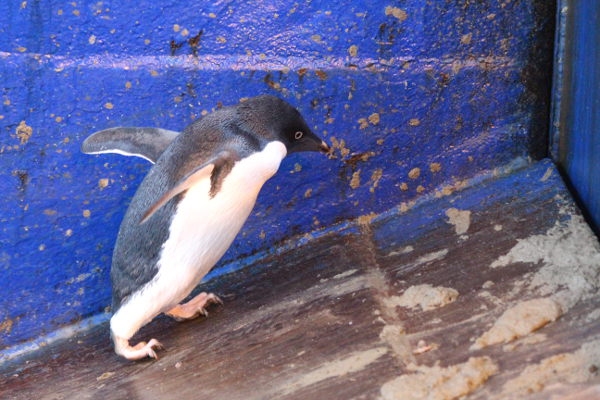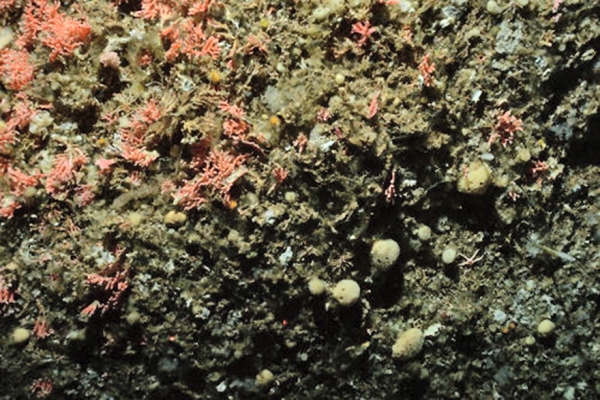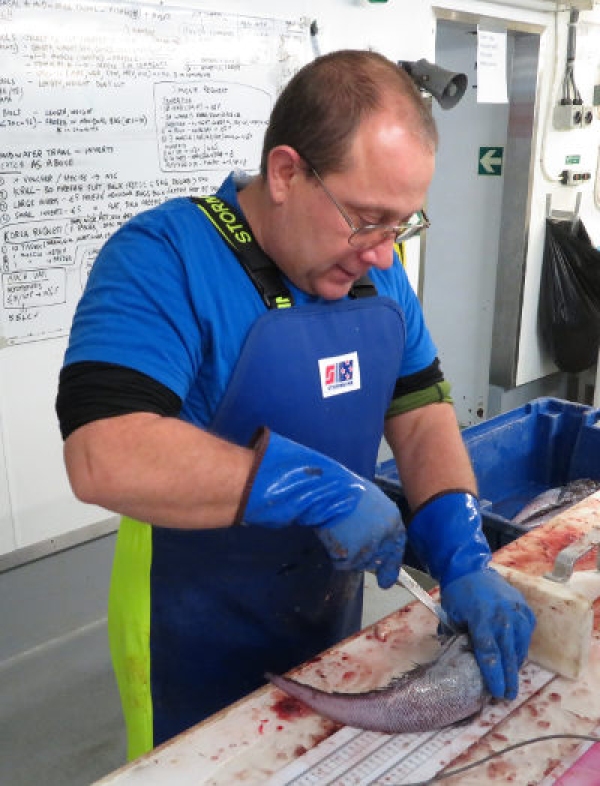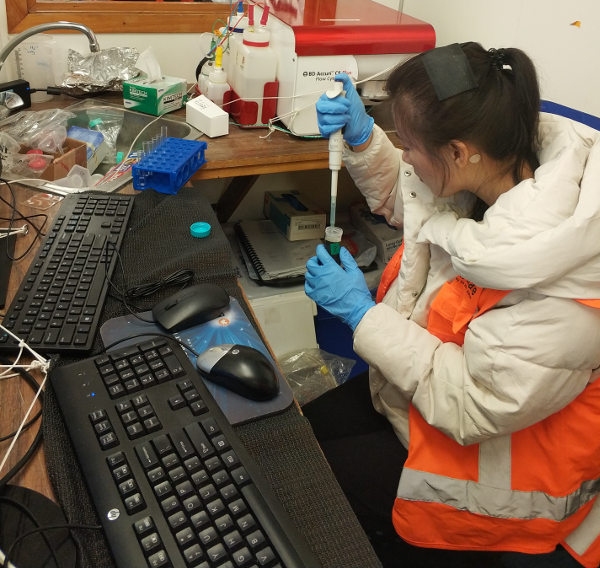3 February 2019. By Voyage Leader Dr Richard O'Driscoll.
It's Day 26 of the Ross Sea Environment and Ecosystem Voyage 2019 on RV Tangaroa and we are now deep in the central Ross Sea at 76 degrees south.
Despite being so far south, the surrounding area is completely free of sea-ice with only the odd iceberg appearing on the horizon. With the mainly settled weather we have had for the past week, it is sometimes hard to believe we are in Antarctica! On my two previous voyages to Ross Sea on Tangaroa in 2008 and 2015 we couldn’t get anyway near where we are now as the whole area was covered in thick sea-ice. In 2008 we were chased out from a position 180 miles west of here as the sea froze around us! It is impossible to know yet whether this year’s lack of ice is just annual variation or the “new normal” in our changing world. That is partly what we are here to find out.
One Ross Sea resident seemingly struggling with the lack of sea-ice this year was an Adelie penguin who climbed up the stern ramp last Wednesday afternoon. It seemed quite happy and got a few hours’ rest on this strangely shaped and noisy iceberg substitute called Tangaroa! Of course our guest also quickly became one of the most photographed penguins in Antarctica as the day shift turned paparazzi. There were plenty of photos (and even the odd selfie) to show to those of us on the midnight shift who missed out.
Progress on the science objectives has been good. We have now completed 24 of our planned 30 sites in the demersal survey. We have had good catches of rattails, both on the bottom and in midwater, and the pattern of distribution we are seeing matches well with historical by-catch rates in the toothfish longline fishery. We also pulled up an old whale skull on Friday, which was covered in its own fauna of worms, sea spiders, and tiny limpet-like molluscs. And on Saturday we caught (and tagged and released) our first large Antarctic toothfish for the trip.
Last Thursday we carried out three underwater camera drops using the deep-towed imaging system (DTIS) in a region where fishers had reported concentrations of vulnerable marine ecosystem (VME) indicator organisms like sponges and corals. Our camera footage confirmed the presence of high abundance and diversity of benthic (bottom) animals, especially hydrocorals in this area—which is now protected as part of the special research zone of the Ross Sea Marine Protected Area (MPA).
The Ross Sea MPA was agreed in 2016 and came into force on 1 December 2017. It was the result of a lot of meetings and consultation between scientists and politicians from the 25 member nations of the Commission for the Conservation of Marine Living Resources (CCAMLR)—led by New Zealand and the United States, who jointly proposed the MPA in 2012. The Ross Sea MPA is the largest MPA in the world (covering over a million square kilometres) and represents a major contribution to global marine protection, but it has not been established in perpetuity. The CCAMLR membership will assess the scientific progress made in the MPA every 5 years, and will evaluate if the objectives are being met, are relevant, or could be improved, every 10 years. After 35 years the whole MPA will be re-assessed and CCAMLR needs to agree by consensus to continue the MPA beyond this time.
CCAMLR strongly encourages nations to collaborate with each other on research and monitoring of the MPA, and on this voyage we are working in partnership with scientists from six other countries. Deployment of ARGO oceanographic buoys is carried out on behalf of United States researchers, Australia has provided one of the instruments on our whale listening post moorings, and we are collecting genetic samples of fish for scientists in South Korea. And of course, as I have mentioned previously, we have 4 international participants on the voyage.
I introduced Brivaela Moriceau and PhD student Natalia Llopis Monferrer in my report of 24 January. Both are working in France, although Natalia is proudly Spanish. Briva and Natalia are working on the role of tiny organisms called diatoms and Rhizaria on the oceanic silicon and carbon cycles, which is important in understanding the biological response to climate change. Neither Briva nor Natalia had been to Antarctica before. Briva says that getting used to sleeping at night with the noise of the work going on 24/7 has been a challenge, but she has already got to fulfil one of her dreams by seeing two groups of orca. Natalia and Briva are often found at their microscopes with straws in their mouths. Turns out that these are attached to micro-pipettes used to take tiny water samples. As Alfred, one of the ship’s engineers said, it is real “suck it and see” science!
I also mentioned Italian scientist Simonepietro Canese in my last report (29 January). Simone is an Antarctic veteran. This is his 7th visit to the Ross Sea. Most of his research has been working from the Italian base of Mario Zucchelli Station in Terra Nova Bay. Simone and his colleagues are part of a long-standing collaboration that New Zealand has developed with the Italian Antarctic Research Programme. I was lucky enough to join Simone at Mario Zucchelli Station in 2017—where we melted holes in the ice to study Antarctic toothfish and silverfish—so it is a pleasure to be able to return the favour and host him on Tangaroa. Based at ISPRA (Italian National Institute for Environment Research and Protection) in Rome, Simone’s research focuses on deep sea biodiversity, taxonomy and ecology. He has been particularly fascinated by the coral habitats that we are discovering at depths of more than 1000 m with DTIS. Before this voyage, Simone says his knowledge on these habitats was limited to samples collected by grab or dredge, so it is exciting to see the species alive and interacting in their natural environment.
Our final international participant, Mengxiao Zhou, is a Masters student from Shanghai Ocean University in China. She works in the Polar Marine Ecosystem Group, which is led by her supervisor Guoping Zhu, who is a member of the Chinese CCAMLR delegation. This is Xiao’s first time in Antarctica—in fact it is the first time she has been anywhere outside China – so putting up with us and our Kiwi ways must have been a huge culture shock! Xiao says her biggest challenge has been coping with seasickness on the voyage south, and missing her family and friends, but she has got into all aspects of shipboard life with a smile.
Although her research is in oceanography, Xiao is collecting fish samples for her colleagues, and helping with the phytoplankton work. She also joined with the rest of her shift in discovering the delights of Antarctic krill cooked in the toasted sandwich maker!
We have only a couple of days left in the southern Ross Sea before we turn north and start working our way back to Wellington. The next leg of the voyage will take us across the Ross gyre—a large clockwise current system that has been rarely sampled because it is usually under ice. The work will focus on oceanography, plankton, and mesopelagic fish and I’ll write more on this in a few days’ time.




